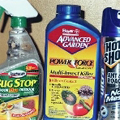Bird Mite Infestation › Forums › General Discussion › Please Help!!
- This topic has 8 replies, 6 voices, and was last updated 1 year, 4 months ago by
Helga.
-
AuthorPosts
-
-
October 9, 2022 at 4:56 pm #6320
NewJersey201
ParticipantDear Birdmites.org & Community,
I really need your help. I have been dealing with bird mites for the last several months and they have upended my whole life and health. I thankfully had a friend who saved me from my apartment and the situation but now I have to figure out what to do with the things that I left in my apartment.
I am finally in a place where I do not see or feel bird mites on or around me often. And I am so grateful because it took months to get here. my friend is going to let me stay with her as I rebuild my life. However, I don’t know if anything from my apartment is salvageable. Can you help/guide me?
Currently, in my apartment, the bird mite source has not been found/removed and has only been treated once. So, I am concerned with what I can keep from the apartment if anything. I don’t want to bring bird mites to my friend’s house or waste money storing things if they will remain.
Has anyone had success moving furniture from a bird-mite-infested home without bringing them with you?
How about when you stored items? What has been your experience? Does it make sense to try? If it does make sense how should I store items that I move to a new location or storage>
How long do bird mites live? I have read that the red mite can live up to 9-12 months. Can they live longer? What has been your experience?
How long do bird mites stay in:
Wood furniture?
Fabric headboard? lamp shades?
Electronics like TVs, printers, paper shredders, cable boxes, routers, and kitchen appliances?
Clothes like dresses/pants, sneakers, shoes/boots, pocketbooks, coats, hats, etc.?
House goods like candles, bible, books, pictures, luggage, etc.?Can they get into plastic storage bins?
Or should I get rid of everything? Is it useless or futile because they can live for a while?
Any help, suggestions, or guidance would be extremely helpful and appreciated. Thank you all 🙂
-
October 14, 2022 at 11:41 am #6418
Flgirl
ParticipantI wouldn’t bring anything with you! I have moved 2 times from these things. The 1st time I brought a camera, coffee maker, clothes, a car, and a speaker. It took 3 weeks for the mites to infest the new place. I just recently moved again and bought everything new and some managed to cling on the new stuff but it is 90% better now. If you can buy everything new again, I would not risk it. I have left my car and apt for 2 months and they still lived. I had stuff bagged for 6+ months and they still lived.
-
This reply was modified 1 year, 7 months ago by
Flgirl.
-
November 2, 2022 at 4:25 pm #6491
NewJersey201
ParticipantHey Flgirl,
Thank you so much for sharing. Your guidance is appreciated. This has been such a nightmare. I hope you are doing better now 🙂
-
This reply was modified 1 year, 7 months ago by
-
October 18, 2022 at 12:42 pm #6424
Feelinghopeless
ParticipantGirl, if you have gotten away from them, leave your stuff. It’s not worth it.
I moved twice without success. They can live for crazy amounts of time on everything. I’m nearly 3 years in and I’m only just finally near the end of it all. Your possessions aren’t worth your health and sanity. X
-
November 2, 2022 at 4:26 pm #6492
NewJersey201
ParticipantHi Feelinghopeles,
I appreciate you sharing! Thanks for the suggestions and for taking the time to reply.
Hope you are doing better now too!
-
-
November 2, 2022 at 4:28 pm #6493
NewJersey201
ParticipantDear @Birdmite Blog Organizer(s),
I am reaching out to see if you had any feedback for me as well. I would really welcome input from you too since you have seen and heard it all, as it relates to bird mites.
Thanks,
Chris -
November 3, 2022 at 7:38 pm #6500
milly
ParticipantDear NJ201 – have you had a positive identification of bird mites? I ask because I think there are many who can’t be sure. I’m one of them. Although my symptoms are the same as most people on here, I can’t be positive because I’ve never actually trapped one for id purposes. I’ve done so much reading and research on this but I guess you need an id before you can solve the puzzle. I’ve been looking at the life cycle of birmites recently, then more recently the life sycle of sandflies – both seem to live a long time and both have slow life cycles, (depending a bit on weather and humidity. Reading the story of the owner of this site, himself a well informed man he appears to be certain that in his case it is bird mites, If you haven’t read it yet, it’s interesting reading and so similar to all the other stories, but it still makes me wonder, unless you’ve actually caught one and had it identified, how certain can you be. Perhaps it doesn’t even matter, it appears that the treaatment is almost the same. Permethrin, apparently kills mites. Not many want to go that route, and neither do I, but as I don’t have any pets or children here, I might use it as a last resort. I could stay away from home for a few nights afterwards. Just myself and my husband live in our apartment and he is not affected at all. Only me. I’m hell bent on finding a solution to this, It’s been 4 years so far, and I’ve followed the do’s and don’ts (well, perhaps not so much the don’ts), and nothing much has made a lasting difference. It’s better than it was in beginning,and slowly slowly getting even better. One of the reasons why I think it has gone on for long 9for me, anyway0 is because I was at a complete loss in the beginning as to know what it was and what to do. I am far more informed now and in every case, I think it’s a slow process. By the time you know you have a problem, the problem has already got out of hand. I’m using a spray filled with ammonia at the moment, spraying everything from drapes to ceilings anad floors. The same ceilings and floors that have been washed and steam cleaned a million times and the same drapes that have been laundered countless times. The ammonia is obviously no good healthwise, (I do wear a mask whilst spraying, but it has cut right down the number of bites and the hours I didn’t sleep,
-
November 4, 2022 at 10:21 pm #6505
jewels1315
ParticipantIf anyone sees this please help me. I am struggling bad tonight. I am alone, so hopeless. Cell phone is 8609131505… email jewels131415@gmail.com please
-
December 17, 2022 at 3:17 pm #6561
Helga
ParticipantPlease try SULFUR.
These are the products I used. Sulfur was the SILVER BULLET for me:
1. Pierce’s “All Purpose NU-STOCK” 12 oz. This is a veterinary product available online thru Chewy.com etc. Apply small amounts to the skin where bitten or hives develop, and wipe off within 20-30 mins., keeping a close eye on how your skin responds. Warning – Test it first, some folks can be allergic. This paste/cream contains 73% sulfur, 25% mineral oil & 2% pine oil.
2. Veterinary Formula Clinical Care “Antiparasitic & Antiseborrheic Medicated Shampoo” for dogs, 16 oz. Contains coal tar, salicylic acid & micronized sulfur (1%). Leave on whilst showering for 5 mins. Again, keep an eye on to make sure your skin tolerates sulfur.
3. Humco (or whatever brand you find) “Sulfur USP. Sublimed Powder, Flowers of Sulfur” 4 oz. This is a backup for mixing in small amounts to the shampoo (which has only 1% sulfur) to increase sulfur content as needed/tolerated.Lethal Temperatures, Methods:
1. A good chest freezer at lowest setting to reach the -5F/-20C that will kill Dermanyssus Gallinea and eggs when exposed for 24 hours. (Laboratory procedure. See Control of Poultry Mites (Dermanyssus), by O. Sparagano, Editor, 2014.) Recommend 72 hours for an object to reach required temp). E.g. Frigidaire model R600a.
2. Clothes dryer. 30 minutes at temp 120 or higher.In my situation:
-Vacuuming did little to help.
-Pesticides, insecticides did not help.
-It is best to avoid carpets and rugs.
-I was never able to get a positive identification, but a mite had been found in a rat dropping.
-The offenders did not stray far from the food bowl (me). They were not “everywhere & in everything” as I had originally feared, but primarily in areas where there had been prolonged contact such as sheets, pillowcases, clothing, sofas, keyboard, tablet, phone.
-One of the cats appeared to be affected as well. The other not.
-The sulfur treatments took time (1 yr) to clear up the problem completely, but the effect was noticeable and immediate each time they were used. E.g. the itching from a fresh set of hives stopped completely within 3 minutes of applying the Nu-Stock cream. Gradually the hives & biting became less and less frequent.
-Patience pays off. They can’t multiply without a food source.
Hope this helps!
-
-
AuthorPosts
- You must be logged in to reply to this topic.





